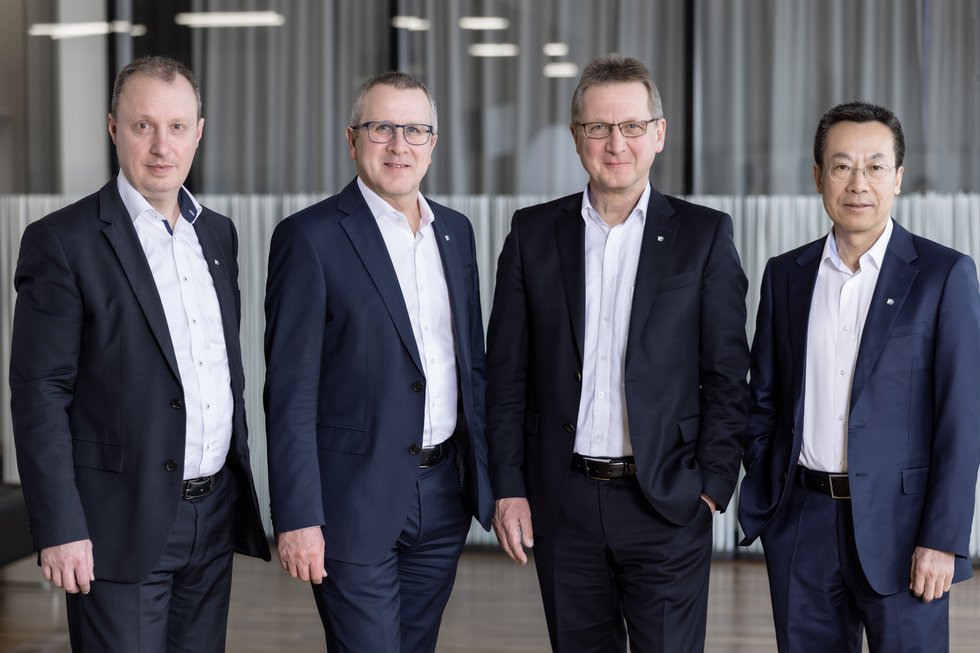Robert Machtlinger (CEO), Andreas Ockel (COO), Aleš Stárek (CFO) and Zhen Pang (CCO) in a discussion on mastering the challenges of 2022 and the successful implementation of the FACC 2030 growth strategy amidst persistently optimistic forecasts for the aviation and aerospace industries.
Mr. Machtlinger, the year 2022 took a very different course than previously assumed following Russia’s invasion of Ukraine. How did FACC fare in this geopolitically and economically tense environment?
Robert Machtlinger:
Development was indeed quite different from what we had expected. 2022 proved to be an extremely intense year with a host of unexpected responsibilities. In the fall of 2021, we were still working on the assumption of global stability, and the first weeks of 2022 continued to point in this direction. Then, on 24 February all the signs were reversed – accompanied by the usual repercussions, ranging from further destabilization of supply chains and upheavals on the energy markets to a massive increase in inflation and still fiercer competition for talent.
Despite all this, the air travel market has continued to make a sound recovery since the coronavirus restrictions were lifted, and consumers have taken full advantage of their newfound freedom to travel – even if international travel in particular has not yet returned to pre-coronavirus levels. This has also led to a strong increase in demand for aircraft, particularly for short- and medium- haul aircraft, most notably the A320 family, which is so important for us, but also for the A350 and B787 platforms along with business jets. For this reason, we anticipate very strong growth potential again in the next few years.
Within this environment, we were able to win a number of interesting new contracts in 2022, including some outside our core business, and to transfer some projects to series production. We are also pleased to report an above-average increase in development work. In this area – on top of invoicing ongoing projects – we also succeeded in generating one-off payments for development work carried out in the past. This has generated both additional cash flow for us and a contraction in our balance sheet, while also removing future risk from the business as these payments were conditional on the number of units produced. In total, our revenue thus grew by around 20 percent to EUR 607 million in 2022 – and hence more strongly than anticipated. However, profitability has suffered under the pressures of inflation.
To what extent has the Ukraine war affected your business performance?
Robert Machtlinger:
Fears that Russia’s attack on Ukraine would have yet another negative impact on travel volumes have not materialized. We are monitoring the development of the conflict very carefully and are liaising very closely with our customers. Even though FACC does not have any relationships with suppliers in Russia or Ukraine, what remains is an exorbitantly high level of inflation, driven by enormous energy costs, which particularly affects our business location in Europe and will continue to do so in the future. In the medium term, this might make it expedient to expand our locations in North America, India and Asia. In terms of products, we have discontinued shipments of components to a Russian customer. The resulting loss of revenue is less than 1 percent of Group turnover and is therefore negligible.
Andreas Ockel:
As previously alluded to, supply chains already impacted by the coronavirus pandemic were subject to further pressure in 2022 as a result of disruptions to material supplies and a worsening shortage of skilled labor. Inflation triggered by the war has led to very high pressure on prices, which we have proactively addressed. We also faced massive additional costs in logistics, but by the end of the year these had already begun to decline.
And then, as you know, energy costs rose dramatically, but thanks to our hedging strategy this did not have a full impact on us. We are also in the favorable position here that we have been using geothermal energy since 2006 and today only derive around 18 percent of the energy we need from natural gas. This means that our dependence on fossil fuels is relatively low. However, to counter possible bottlenecks in gas supplies, we can also use oil as a back-up fuel in an emergency through an investment in combined gas/oil burners. On top of this, we are making increased use of green electricity produced in-house from our photovoltaic systems and are also purchasing electricity generated exclusively from hydropower.
Robert Machtlinger:
As far as aircraft demand is concerned – and consequently the demand for our products – the Russian market is of modest importance, accounting for around 2.8 percent of the projected additions to the worldwide fleet by 2041. From a global perspective, therefore, we are talking here more about a haziness in terms of planning ...
And what is the operating result like with all this in mind, Mr. Stárek?
Aleš Stárek:
Somewhat mixed due to the environment. Unlike revenue, our operating result did not increase significantly compared to 2021. At times, we had to shoulder substantial price increases for materials as well as higher logistics and energy costs, while the index-based price adjustments are always applied to our customers after a certain time lapse. This has naturally put pressure on our earnings. At EUR 5.5 million, however, our EBIT is positive, and the trend is pointing upwards.
Cash flow in the year just ended was EUR 10 million, while net debt amounted to EUR 188 million on the balance sheet date, which represents a slight increase. The underlying reason for this is that, in view of the uncertain supply chains, we have built up our inventories of materials and thus our working capital in order to be able to meet our customers’ growing demands reliably.
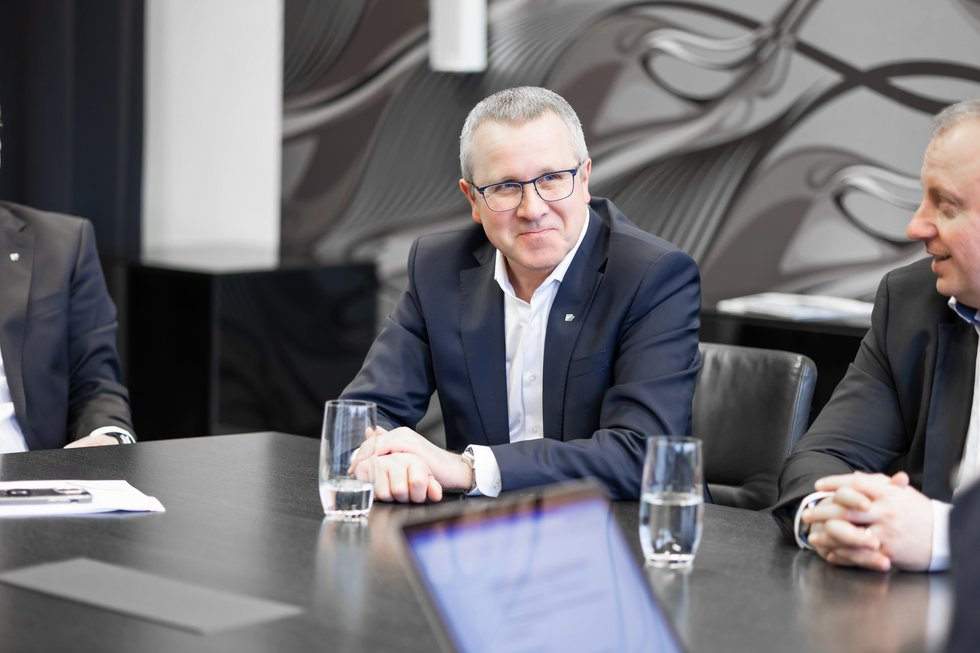
Speaking of growing demand: Judging by the recovery in aviation, the positive long-term forecasts, which assume steadily rising travel volumes and a correspondingly high demand for new aircraft, are likely to remain intact ...
Andreas Ockel:
Yes, the upswing is unbroken, and the industry is literally taking off. However, there are different phases with different rates of increase. In 2022, we witnessed peaks in new aircraft orders, but at the same time, aircraft manufacturers were forced to slow down the ramp-up in view of the constraints on global supply chains. By way of example: Airbus had to scale back planned production of the A320 family from 720 to 700, and then in the end 661 new aircraft were delivered in 2022 (excluding two aircraft for Aeroflot, which were affected by the sanctions against Russia).
The main reason for this are bottlenecks in the supply of materials. While the airline industry itself has not been affected by this, aircraft manufacturers certainly have. Added to this are the sharp increases in energy prices. The situation is also very strained in the area of human resources, making it a major challenge to meet delivery targets. In order to achieve these, we have been intensively involved in our supplier chain, in some cases even ensuring on site that production of the materials and components that are crucial for us is up and running. As a result, 2022 proved even more of a challenge, but at least the situation with regard to travel saw an improvement compared to 2021 and will ease further now that the coronavirus restrictions, especially those in China, have been lifted. Throughout 2022, and most notably towards the end of the year, we succeeded in meeting our customers’ needs to almost 100 percent. Key to this was excellent teamwork, and my thanks for this outstanding performance go to the entire FACC crew!
Robert Machtlinger:
The increase in our revenue is compelling proof that the measures we have taken to safeguard our supply chains have had the desired effect and that we have once again been able to demonstrate our delivery reliability. All in all, we have weathered the difficult situation well and will continue to do so in 2023. In any case, our overall market forecasts are optimistic. They are also confirmed by the traditional 20-year forecasts issued by Airbus and Boeing, both of which predict a demand for around 40,000 new aircraft by 2041. In any event, we expect further revenue growth in the region of some 10 percent in 2023.
Incidentally, we have been given very positive feedback on the measures we took in 2022 – our customers are extremely appreciative of the fact that we have adjusted to increasing demand in good time and are meeting our delivery obligations. Not all companies operating in the industry have managed to do this.
Does this mean that you are enjoying continued success in implementing your FACC 2030 strategy, which focuses on growth in all of your business segments?
Robert Machtlinger:
Definitely. From today’s perspective, we are well on target at many levels. For instance, the expansion we are pursuing in our traditional business with the aircraft industry is progressing according to plan. In this context, our customer and platform strategy plays a key role. An example of this is the A220, for which we signed major contracts for structures with Airbus in 2021. From 2025, the A220 will be the second most important aircraft platform we serve. In figures, our revenue from components for this type of aircraft is expected to rise from just under USD 30 million in 2022 to USD 100 million by 2025.
However, there are also plenty of other good opportunities in the aircraft market. For example, we receive numerous inquiries in the Aerostructures sector. Currently, a redistribution of work packages is taking place here, moving away from critical or non-competitive suppliers to strategic and innovative partners. This is where we see good opportunities for FACC to gain additional market share. In view of the above-average growth in this segment, we expect the structure business to be our largest revenue generator in 2023. At the same time, we are also registering considerable interest in business jets. In terms of medium-sized aircraft equipment in this segment, we are now number one on the world market and serve around 60 percent of global demand.
However, we are also successful in opening up new markets – specifically the increasingly dynamic Urban Air Mobility segment and the business field Space. It is our goal to generate around 20 percent of our revenue from these new activities outside the regular aircraft business by the end of this decade. Meanwhile, in collaboration with Archer we launched a major new project in Urban Air Mobility in 2022 that complements our strategy perfectly.
Similarly, our ongoing project in the Space segment – the kickstage for the Ariane 6 launcher of the European Space Agency – is proceeding according to plan. In parallel, we are holding talks with potential European and American customers. Although we do not expect any significant turnover in this segment before 2027, we are very satisfied with the success we have achieved to date in terms of business development.
This growth also calls for innovation ...
Robert Machtlinger:
Of course it does, which is why we are constantly and resolutely working on our technological development and a broad range of innovative projects in parallel to expanding our traditional business and opening up new markets. The most important topics here are sustainable production, the use of new materials, especially thermoplastics, the development of biomaterials and recycling based on life cycle assessments of our products. Here, too, we are well under way and have exciting ongoing development projects with each of our major customers. Our objective is to work closely with our customers to achieve sustainable flying by 2050.
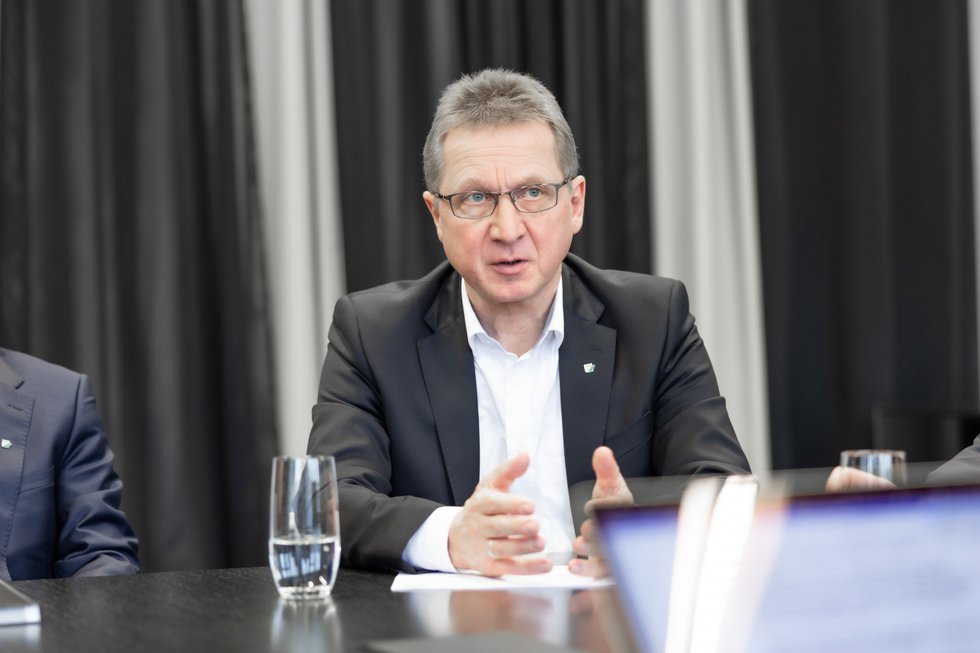
… and equally a perfectly positioned production process ...
Andreas Ockel:
This addresses several issues at once: on the one hand, our global manufacturing footprint and, on the other, the question of where we manufacture specific products. In the last two years, we have taken a very important step towards implementing our strategy by establishing a new plant in Croatia. The plant has been producing seamlessly since the end of 2021 and validates our decision to make this investment, which serves not least to reduce costs. Several projects were transferred to Croatia as planned, and Plant 6 is producing cabin products of outstanding quality for the A320 family on a stable basis. Having initially implemented the investment in Croatia on a somewhat smaller scale due to the crisis, we are now in fact in the process of expanding the site. Our medium-term goal is to enlarge the workforce from the current 200 to around 600 employees. Incidentally, one of Croatia’s key advantages as a location is that it boasts superbly trained specialists.
When it comes to production, though, we are also talking about our vertical integration of manufacture and our degree of integration, which we are constantly improving for reasons of efficiency and cost, but also in order to reduce our dependence on critical suppliers. Most recently, for example, we transferred the production of metallic components to our own operations. We thus produce the fittings for our translating sleeves ourselves. We have also launched further projects in this field, e.g. metallic components for our A220 elevators and rudders. To this end, we will be expanding production capacity through further investments, which very clearly underlines our new area of expertise.
But we are not only expanding the scope of our production, we are also constantly progressing in terms of production methods and processes. We are particularly proud of the fact that we were able to set up our first assembly moving line for the manufacture of cabin products in 2022. In this instance, we have achieved a significant increase in productivity by means of a targeted investment that will be recouped within a short period of time. We are also delighted that the feedback from our employees regarding the new production line has been very positive. Facilitating work processes and increasing productivity go hand in hand.
At the same time, we are continuously working on increasing the degree of digitalization of the shopfloor and are well on the way to achieving paperless production. This naturally enhances process stability and the quality we attain. Production is supported by a new computer-aided quality system that detects irregularities before a failure even occurs. This is extremely helpful, especially when starting up new projects. In the same vein, we have switched our logistics operations to digital, paperless processes under the title “Digital Warehouse Management”. This not only improves traceability, but also provides us with a permanently up-to-date inventory.
Did 2022 see any exciting new contracts?
Robert Machtlinger:
Yes, it did. There were in fact a whole series of interesting new projects that reinforce our path towards growth and diversification. That said, we are not allowed to talk about the majority of them in public. I can mention one particularly exciting project, though, in the field of urban air mobility, which we briefly touched on earlier: We have been commissioned by Archer, a publicly listed American start-up, to develop fuselage and wing components as well as the interior for a new electrically powered light aircraft with vertical take off. The project also involves United Airlines and Stellantis, one of the leading global automotive manufacturers, while we ourselves are acting as a technology partner. Without doubt, this contract represents a major milestone in the development of this new market.
Alongside this, the aftermarket sector is also developing very positively. Our facility in Florida, which was launched in 2021, is already refurbishing its first aircraft, and business in general is starting to pick up again after the crisis. We were also able to win a contract from an American customer for the maintenance of composite engine components, and this project alone will generate annual revenues of USD 10 million as of 2023. All this demonstrates that the investments and ratifications of recent years are now paying off.
And how is the market developing in China?
Zhen Pang:
If you look at current forecasts, China is set to be the third largest aircraft market in the world after North America and Europe in the next two decades – Boeing, for example, expects Chinese airlines to add almost 8,500 new aircraft to their fleets by 2041. For FACC, this also entails very interesting prospects. The production rates of the two Chinese aircraft platforms on which FACC is currently represented are proof of this: series production has just started for the COMAC C919, which received its type certification in 2022. Four units were delivered in 2022, the number is expected to be roughly double in 2023, and a further increase of approximately 100 percent is forecast for 2024 compared to 2023. FACC manufactures cockpit and cabin equipment as well as spoilers and winglets for this aircraft. Similarly, the annual rate for the ARJ21, for which FACC produces the cockpit and passenger cabin, has stabilized and is expected to remain at this level over the next few years. Incidentally, the C919 will be of similar importance to FACC in the medium term as the A320, accounting for an annual sales volume of around EUR 100 million.
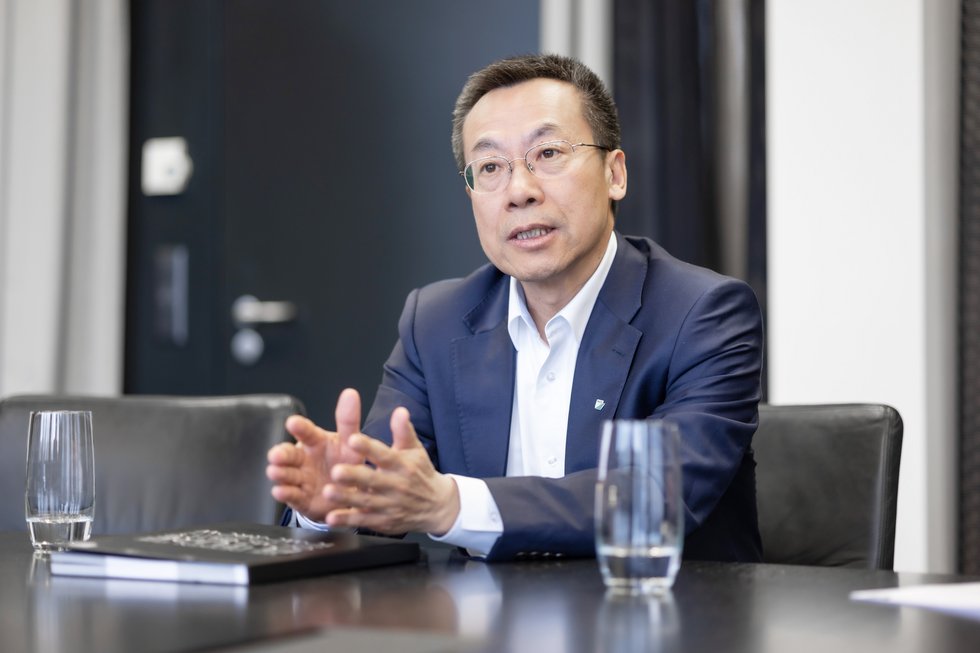
How important is sustainability for FACC? You did, after all, formulate concrete sustainability goals last year along with a roadmap for their implementation …
Robert Machtlinger:
In doing so, we have defined matters in concrete terms and translated them into figures that we have been implementing in the company for a long time. Sustainability is an integral part of our strategy as it is beyond doubt that our entire economy and society must become more sustainable. FACC already implemented projects to this end at a time when sustainability was not yet a hot topic. One example of this is our use of geothermal energy and photovoltaics, which we have already spoken about today and which has made us largely independent of fossil fuels. But we also consciously select environmentally friendly materials or even biomaterials and consistently recycle, all the way down to a circular economy. Quite apart from this, we believe that our business is inherently sustainable as our products make a significant contribution to weight reduction and thus to preventing CO2 emissions in the aircraft industry.
Aleš Stárek:
Sustainability goes far beyond the issue of the environment; our overall strategy takes into account all aspects of the ESG concept and therefore encompasses not only financial targets but also those relating to ESG. We also consciously involve our suppliers through our Code of Conduct, which has been in place for many years. All in all, we have progressed so far along this path that we do not have to apply the Taxonomy Regulation to determine which requirements we meet, but rather how we can present our achievements.
The business world is currently complaining almost with one voice about an acute shortage of skilled workers. Where do you stand in this respect?
Robert Machtlinger:
We have not been caught unawares by the demographic change and the change in people’s perceptions of their work. Last year, we held around 1,800 job interviews here in Upper Austria and brought about 300 new employees on board, not to mention another 100 or so in Croatia, which shows that we are well prepared. As a company, FACC is interesting for the labor market. People from 45 countries work here for us – and that in a region that is not exactly centrally located.
We attach great importance to professional employee onboarding and the long-term retention of existing employees. That is why we are currently developing a concept for a new FACC Welcome and Training Center. For in the next 18 months we will need around 600 additional employees who we hope to integrate into the company as quickly as possible. Parallel to this, we are investing significantly more in management development. This is an essential prerequisite for us if we are to be able to lead the company successfully into the future.
At this point, I would like to mention a Smart Mobility project from a year ago that falls into the category of employee retention: To ease the burden on our employees as they face massive general cost increases, we are providing carpools of four to seven people with an electric vehicle that can be recharged at the plant. In this way, we have created a win-win situation for our employees and the environment. It is not surprising that this offer has been very well received. Based on an internal survey conducted in January 2023, more than 380 employees have already expressed an interest in an e-carpool of this kind.
What is the current situation with regard to investments?
Andreas Ockel:
Following completion of the plant in Croatia at the end of 2021, our investments in 2022 were primarily channeled into new projects or rate increases for existing orders. For instance, we invested in the Archer project mentioned earlier and a new winglet for the Dassault Falcon 10X. Rate increases were also made in wing-tobody fairings for the A220 and baggage compartments for the A320 family. We also invested in occupational safety, especially fire protection. The next stage of expansion is set to take place in 2023 at the new plant in Croatia.
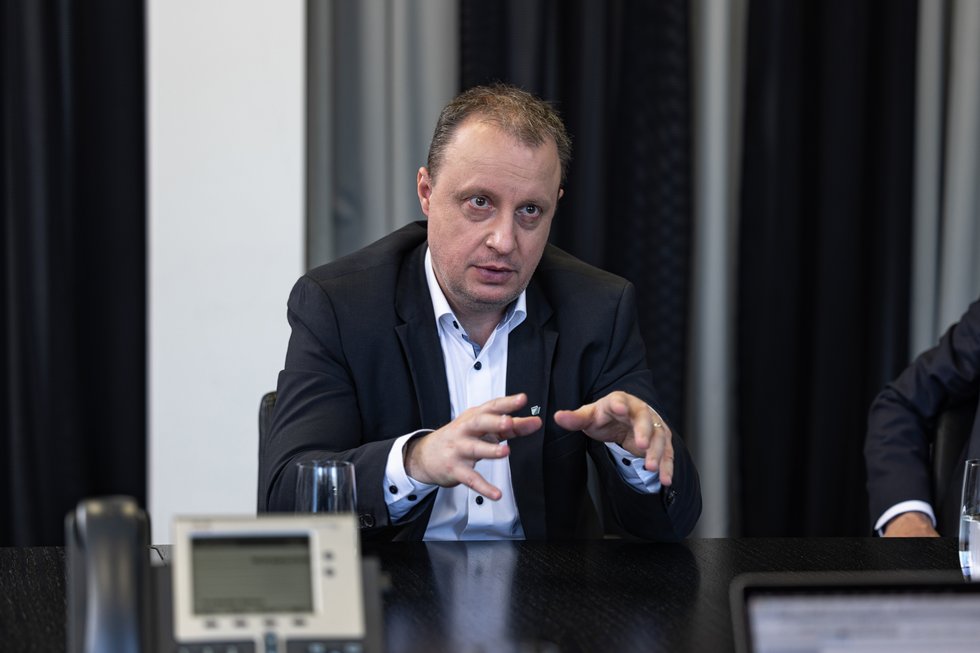
Mr. Stárek, immediately before this interview you signed the contracts for a new syndicated loan. This means that you succeeded in refinancing the old loan at a very early stage …
Aleš Stárek:
We owe this to the fact that, in view of the difficult geopolitical situation which is also having a massive impact on the financial markets, we began negotiating an extension very early on, even though the old syndicated loan would not have lapsed until August 2023. This proved to be a very wise move as loans are being granted with far greater restraints in the current climate. The volume of the new loan remains unchanged at EUR 225 million, and the interest expenditure will obviously increase to reflect the current interest rate landscape. We are extremely happy that our five Austrian core banks continue to be part of the syndicate.
This financing enables us to set the strategic course for the future of our company. The focus is placed heavily on further expanding our plant in Croatia and on investing in new projects. Since we produce almost exclusively for export, a large part of this is accounted for by export investments supported by the Austrian Kontrollbank/OeKB. While the new financing also offers more flexibility for dividends, there will be no payout for 2022 at this stage.
This brings us to your share. How does the capital market view its current performance and potential?
Aleš Stárek:
In the overall difficult market environment of the past year, our share also declined in value; with a drop of around 25 percent, it fell even more sharply than the Austrian market as a whole. When compared to the aerospace market overall, we are thus roughly on a par with our (purely civilian) peer group. However, interest in the FACC share continues unabated, and we are holding ongoing discussions with investors and analysts. Since many investors have become more selective and only contact companies in which they are really interested, this is a positive signal. Many investors see the potential in aviation-related shares, but it will be a while before this actually manifests itself in share acquisitions. Aviation will certainly need a few more quarters before it is fully recovered in the wake of COVID-19 and the same applies to shares in the aerospace industry. Since the beginning of 2023, however, our share price has risen steadily again and was most recently trading above EUR 7 once more.
Mr. Machtlinger, you have employed the FACC 2030 strategy to embark on a global growth path that focuses on vertical integration, high quality technology, and new applications beyond your core business in the areas of Urban Air Mobility and Space. What is your outlook for 2023?
Robert Machtlinger:
Both the rising volume of air travel and our customers’ forecasts confirm the growth assumptions of our strategy. Even if the surge in growth experienced by the short- and medium-haul aircraft segment is somewhat less pronounced due to a variety of factors, we expect demand for this segment, which accounts for around 80 percent of the aircraft on order, to increase by around 10 percent in 2023. However, the market for long-haul aircraft will also grow by around 20 percent over the next 24 months thanks to an increase in international travel. Against this backdrop, the expansion of our site in Croatia and the widening of our manufacturing and product portfolio at our plant in Wichita, USA, will enable us to implement key milestones in terms of globalization.
At the same time, we are focusing on our supply chain as the performance delivered by our supplier partners is a key driver of FACC’s success: more than 55 percent of our value creation lies in the purchase of materials and components. For this reason, we intend to substitute less innovative supply chains or suppliers that fail to meet the requirements of the market sustainably with strategic partners or by integrating them into our own value chain. In addition to reducing costs, we also aim to drive innovation beyond FACC, because only in close cooperation with our suppliers will we be able to satisfy the increasing demands placed by the market on a tier-1 partner in the long term.
Our research and technology projects are running according to plan and are being rigorously pursued in close coordination with our customers and development partners. The aim here is to provide maximum support within the technological transformation towards CO2-free flying and to offer our customers the technologies they need for the next generation of aircraft in a timely and secure manner.
Our new partnerships in Urban Air Mobility are also continuing to develop positively. By developing new products and using new materials and processes, we are paving the way for a new type of lightweight technology that allows large volumes to be manufactured efficiently and inexpensively. The transfer of these new processes to our core business harbors additional medium- and long-term opportunities.
Overall, we expect that the planned growth will largely translate into increased profitability and thus higher EBIT.
